 |
 |
|
Gassaway
|
 |
|
Dundon
|
 |
Ansted
Gauley Bridge
Glen Jean
Mt. Hope
Thurmond |
 |
|
Alum Creek
Branchland
|
 |
|
Logan
|
| Chamber of Commerce |
 |
|
Davy
Iaeger
Kimball
Roderick
Twin Branch
War
Welch
|
 |
|
Historic Matewan
Williamson
Dingess
Red Jacket
|
 |
|
Itmann
Mullens
Oceana
Sabine
Wyco
Wyoming
|
|
|
|
|
|
|
|
|
|
|
|
|
LOGAN
|
|
HISTORY
|
| Logan County was formed in 1824. It is named for Chief Logan, famous Native American chief of the Mingo tribe. The county seat for Logan County is Logan, although it was once known as Aracoma, named after the daughter of Cornstalk, a Shawnee Chief. The story of Aracoma is told at the amphitheater at Chief Logan State Park each year. In 1921, Logan County was the site of the Battle of Blair Mountain, one of the largest armed uprisings in U.S. history. Click here for more information about the Battle of Blair Mountain and other mining disasters. |
|
| One can see view the City of Logan building that was once the train station as well as the following: |
|
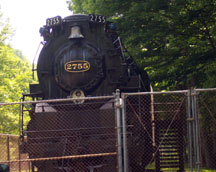 |
On display at Chief Logan State Park is a C&O Lima Locomotive which was placed on the National Register of Historic Places on September 28, 2006. |
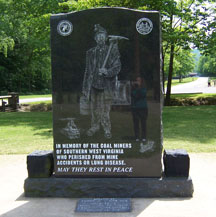 |
Inside the Cultural Center, there is a railroad display as well as memorabilia from the coal mines once very active in this area. A special memorial in memory of coal miners is located just outside the Cultural Center. |
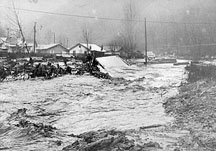 |
The Cultural Center also features a display on the Buffalo Creek Disaster, a solemn recollection of the tragic event which took place Februrary 26, 1972 when a dam broke and killed over 100 people and destroyed an entire town. Click here for more on this exhibit and on the Cultural Center. |
|
| Chafin House
Also known as the Women's Club of Logan - Library
581 Main Street, Logan
Period of Significance: 1920-1924
This was the home of Don Chafin, Logan County Sheriff, during West Virginia's Mine Wars. Years of dissention eventually exploded into open warfare between coal operators and union sympathizers. Chafin's reign in office coincided with the United Mine Workers (UMW) drive to organize West Virginia's southern coalfields. Angered by abuses of power, armed union miners attempted a march on Logan in 1921. They were met at the Boone-Logan county line by Sheriff Chafin and 1300 deputies, mine guards and state police. The ensuing Battle of Blair Mountain raged for over 4 days.
|
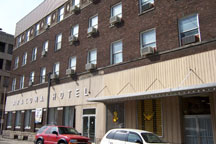 |
The Aracoma Hotel, which still operates today, was the command center during the Mine War. The switchboard they used is on display at the Cultural Center at Chief Logan State Park. |
|
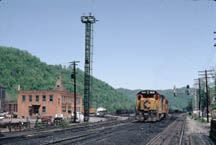 |
Peach Creek Rail Yard - photo shows train leaving Peach Tree Yard eastbound for Gilbert Yard. Office of the yardmaster is located in the two story building on the left. Photo taken in 1983 by Everett N. Young. Click here for more photos. |
|
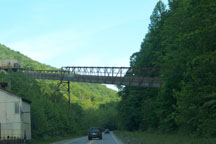 |
Mining is still taking place in Logan County. Conveyor belt crosses over the highway which carries coal from the mine to a distribution center. |
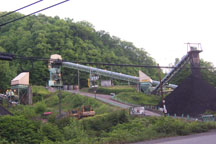 |
Hampton Coal Company is just one of the active coal companies within the county. Their operation is visible from the highway. |
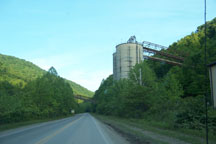 |
Coal being extracted is viewable from the highway. |
|
|
|
| Work is also underway to provide interpretive information at the site of the Battle of Blair Mountain (see below). |
| GHOST STORY: Legend of Mamie on Mine Road 23 is a fasciniating story and there is a museum dedicated to this. Click here. |
| Visit the gallery of Roger Williamson, a local artist who has captured the "remarkable era of the Appalachian Coalfields" in his paintings about coal camps and coal camp life in West Virginia. |
|
| MINING BATTLE AND DISASTERS |
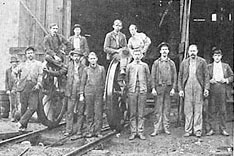 |
Blair Mountain Battle Site is the site of the largest armed uprising in American since the Civil War. The murder of Sid Hatfield incited coal miners from all over West Virginia to take up arms. Sid Hatfield had become a hero of the miners when he stood up to the Baldwin Felts Mine Guards at the Matewan Massacre. In 1921, 10,000 armed miners marched to free Mingo County West Virginia from what they saw as the oppressive control of the coal companies. This force was met by a heavily armed contingent supported by the coal companies on the Logan County line. This battle continued for several days until the U.S. Military was called in and eventually stopped the marching miners. This event was also the first time in history the U.S. Government marshaled bomber airplanes against its own citizens. Click here for more information. |
|
| Two other more recent tragic coal mining events in Logan County were the Buffalo Creek Disaster and the Aracoma Alma Mine accident. |
| The Buffalo Creek Flood was an accident that occurred on February 26, 1972 when a coal slurry impoundment dam built on a hillside in Logan County by the Pittston Coal Company burst four days after being declared 'satisfactory' by a federal mine inspector. The resulting flood unleashed approximately 132 million gallons (500,000,000 L) of black waste water upon the residents of 16 coal mining communities in Buffalo Creek Hollow. Out of a population of 5,000 people 125 people were killed, 1,121 were injured and over 4,000 were left homeless. 507 houses were destroyed, in addition to forty-four mobile homes and 30 businesses. The incident completely leveled the town of Saunders, WV. |
| The Aracoma Alma Mine accident occurred when a conveyor belt in the Aracoma Alma Mine No. 1 at Melville in Logan County caught fire. The conveyor belt ignited on the morning of January 19, 2006, pouring smoke through the gaps in the wall and into the fresh air passageway that the miners were supposed to use for their escape, obscuring their vision and ultimately leading to the death of two of them. The two men, Ellery Hatfield, 47 and Don Bragg, 33, died of carbon monoxide poisoning when they became separated from 10 other members of their crew. |
|
| WHAT DOES ONE DO WITH COAL MINING AREAS ONCE THE COAL HAS BEEN EXTRACTED?
FISH HATCHERIES
An excellent example to post mining land use is the West Virginia Aqua who have built fish hatcheries in both Mingo and Logan counties and are raising Isis Arctic Char on reclaimed coal mine sites using clean, cold water from nearby underground coal mines. The fish, similar in color to salmon although the texture is something between a salmon and a trout, is usually only found in lakes within 500 miles of the North Pole. The fish is free of mercury, PCb's and other toxins and very high in Omega 3 and protein. Established in 2000, West Virginia Aqua have 10 employees and produce over 5,000 pound of artic char a week with plans to increase its capacity to 20,000 in the near future. Visit their website to order online, for recipes, nutritional infomration and more on the company.
TRAILS
Old coal and logging roads are now being converted into ATV, mountain bike and horseback riding trails which are attracting people from all over to come to the area creating a very positive economic impact for the region. In fact, many of the trails on the Hatfield and McCoy Trail in Logan, Mingo and Fayette counties were once old coal roads.
|
| For an inventory of all the tourism related offerings in Logan County West Virginia, click here. |
Logan County is part of the NCHA*, an 11 county initiative* in West Virginia“...to preserve, protect, and interpret lands, structures, and communities with unique and significant historic and cultural value associated with the coal mining heritage of West Virginia.” The counties of Boone, Cabell, Fayette, Logan, McDowell, Mercer, Mingo, Raleigh, Summers, Wayne, and Wyoming are participants in this initiative. Go to http://www.coalheritage.org/ for more information.
*The National Coal Heritage Area (NCHA) is one of only 22 nationally designated heritage areas in the entire United States.
|
|
|
|

